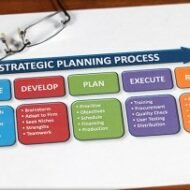Posted by Managementguru in Business Management, Decision Making, Marketing, Strategy
on Jul 12th, 2014 | 0 comments

Stability Strategy in Management The Concept: A stable strategy arises out of a basic perception by the management that the firm should concentrate on using its present resources for developing its competitive strength in particular market areas. In simple words, stability strategy refers to the company’s policy of continuing the same business and with the same objectives. When a product is well accepted and has a brand value in the market, the company would want to expand its market base in that particular product segment to win over its competitors. For example, ‘Old Cinthol’ from Godrej, continues to be the trusted choice of most customers and one of the top most brands in soaps. Especially in rural areas, people prefer Cinthol which comes in different sizes in lieu of customer preference. Panneer Soda manufactured by Kalimark, a soft drink available only in southern parts of Tamilnadu is again a long-standing brand preferred by customers belonging to middle class and lower middle class. This indigenous brand is a direct competitor for coke and pepsi, the soft drink giants in the industry. The same applies to “BOVONTO” again a kalimark product whose growth terrorised giants in the likes of COKE and PEPSI. It is said that some of the multi-national companies tried to crush this small but indigenous and successful company by buying all the glass bottles used for bottling the drink from small retailers. All done by paying high price for old bottles and breaking them so that those bottles were not available for the kalimark manufacturers. Putting up a brave fight, Kalimark has introduced pet bottles (plastic containers) and for managing the dearth of containers they have erected a bottling plant also. Recently Kalimark group has reinvented itself with modern technology for production. The shape of Bovonto pet bottle was redesigned and production was increased. Related Posts: TURNAROUND STRATEGY STRATEGY EVALUATION TACTICS OR STRATEGY The Need for Stability Strategy: It continues to serve the customers in the same product or service, market and functional sectors. Its main strategic decisions focus on incremental improvement of functional performance.’ The focus is on maintaining and developing competitive advantages consistent with the present resources and market requirements. Say, if your business is doing well and you are able to factorize the economies of scale with a fairly decent profit, you would not want to go for expansion in the immediate future; instead you would go for, Sustenance Competitor management and Market share Maintenance Man has an inbuilt fear of change and only very few take that extra step to rage forward by being risk-aversive. Stability strategy suits medium-sized growing firms which have to first get well established in the market and wait for the right time to invest and divest. Companies do not go beyond what they are presently doing; they serve the same market with the present products using the existing technology. The essence of stability strategy is, therefore, not doing anything but sustaining a moderate growth in line with the existing trends. Advantages of Stability Strategy: The firm is successfully run and the objectives are achieved and there is satisfactory performance. Therefore, the management may want to continue with the same activities. A stability strategy is less risky. Unless the conditions are really bad, a firm need not take any additional risks. The management doesn’t foresee any change in the environment or opportunity in the market or any threat. When pursuing this strategy, there is no disruption in routine work. The down side of this strategy may be “setting of boredom” where you tend to do routine stuff, but the brighter side is the continuous positive response...

Posted by Managementguru in Business Management, Marketing, Principles of Management, Strategy
on Mar 16th, 2014 | 0 comments

Strategies to Tide Over Competition Distinctive Competence: is nothing but a set of unique capabilities that certain firms possess allowing them to make inroads into preferred markets and to gain advantage over the competition. Human brain is the greatest think tank and it evolves new methodologies of business management from time to time in order to sustain as well as win the race. Planning is the key factor that decides the rise or downfall of a business empire. “Where we are?” and “Where we want to be in the next few years?” is how every business leader’s basic thought process must be, without which he cannot proceed further in the competitive corporate environment. If we call planning as the basement of a building, then it should be very precise, clear cut and robust so that the business empire built on this basement will never collapse and it will also serve as a role-model for everyone who aspires to set his foot in the corporate business world. At the corporate level, strategic planning helps to establish the Purpose Mission and Objective for the firm as a whole and “outlines the overall plan to attain them.” Strategy is nothing but a unique set of action plan that will distinguish you from your competitors and make you have an edge over them. Likewise strategic planning is nothing but thinking out of the box to” CREATE YOUR OWN NICHE MARKET” in the business environment. STRATEGIC COMPETENCE takes you to the top of the ladder; but to withhold your position you need to formulate innovative ideas to tide over the challenges in the market. Strategic planning facilitates this process by giving you time frame to complete your short term objectives and long term goals. Infographic Courtesy: The 4 key sources to seek insights for marketing planning Planning for SBU’s: Business level planning is done for the enterprise’s STRATEGIC BUSINESS UNITS or SBU’S. These are individual” cash cows” that makes your business noteworthy and also brings in constant revenue to run your other units successfully even in periods of recession or if a particular product is not that successful as you might have expected it to be. I shall compare a business plan to a travel plan. Both involve planning, resources, capital, marketing and so on. . . Both have starting points but a business plan and its objectives never end and you can never come back to the starting point in a business as that of a travel, because you only expand and grow to greater heights in a business provided your plan is pucca. And also the strategy seeks the integration and control of marketing, finance, production and human resources at the functional level. Strategic Plans at different functional levels: Strategic plans at different levels must be integrated to ensure that they work in tandem and reinforce each other, thereby contributing to the corporate level strategy adopted for the entire corporate group. I would call strategic planning as” INTELLIGENCE DESIGN CHOICE ACTIVITY “adopted by a corporate and it has become an inevitable feature in the directory of the business world....




